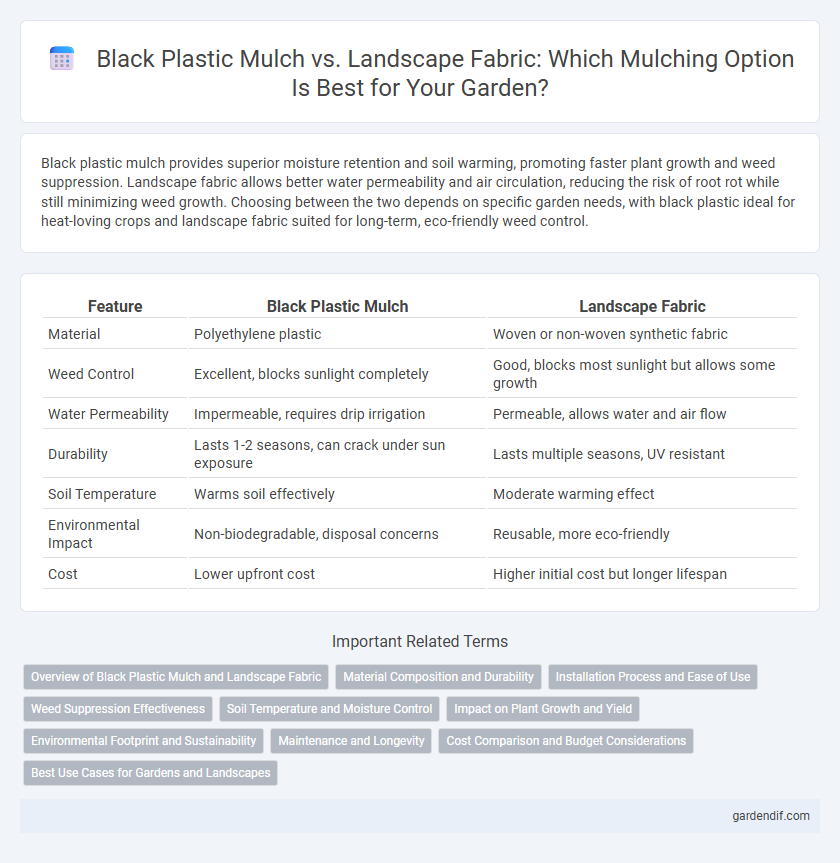
Black plastic mulch vs Landscape fabric Illustration
Black plastic mulch provides superior moisture retention and soil warming, promoting faster plant growth and weed suppression. Landscape fabric allows better water permeability and air circulation, reducing the risk of root rot while still minimizing weed growth. Choosing between the two depends on specific garden needs, with black plastic ideal for heat-loving crops and landscape fabric suited for long-term, eco-friendly weed control.
Table of Comparison
| Feature | Black Plastic Mulch | Landscape Fabric |
|---|---|---|
| Material | Polyethylene plastic | Woven or non-woven synthetic fabric |
| Weed Control | Excellent, blocks sunlight completely | Good, blocks most sunlight but allows some growth |
| Water Permeability | Impermeable, requires drip irrigation | Permeable, allows water and air flow |
| Durability | Lasts 1-2 seasons, can crack under sun exposure | Lasts multiple seasons, UV resistant |
| Soil Temperature | Warms soil effectively | Moderate warming effect |
| Environmental Impact | Non-biodegradable, disposal concerns | Reusable, more eco-friendly |
| Cost | Lower upfront cost | Higher initial cost but longer lifespan |
Overview of Black Plastic Mulch and Landscape Fabric
Black plastic mulch is a durable, impermeable material primarily used to suppress weeds, retain soil moisture, and increase soil temperature, promoting faster plant growth. Landscape fabric, made from woven or non-woven polypropylene, allows water and nutrients to penetrate while effectively controlling weed growth and preventing soil erosion. Both materials serve as protective ground covers but differ in permeability and environmental impact, making them suitable for varying agricultural and gardening needs.
Material Composition and Durability
Black plastic mulch is made from polyethylene, offering a waterproof barrier that effectively retains soil moisture and suppresses weeds, with a typical lifespan of one to two growing seasons before degradation occurs. Landscape fabric consists of woven or non-woven synthetic fibers such as polypropylene or polyester, allowing for better water and air permeability while providing weed control, and can last several years depending on UV exposure and soil conditions. The durability of black plastic mulch is generally limited by tearing and UV breakdown, whereas landscape fabric tends to resist tearing better but may degrade more slowly under constant sunlight.
Installation Process and Ease of Use
Black plastic mulch installation requires laying durable, UV-resistant sheets directly on the soil, secured with staples or soil along the edges, providing a smooth, weed-proof surface but necessitating careful cutting for planting holes. Landscape fabric involves rolling out a breathable, woven material that allows water infiltration, held down with pins or stakes, offering easier repositioning and removal but potentially requiring more frequent maintenance to control weed growth beneath. Both materials differ in installation complexity and user-friendliness, with black plastic mulch offering a more rigid setup and landscape fabric providing greater flexibility for gardeners.
Weed Suppression Effectiveness
Black plastic mulch offers superior weed suppression by blocking sunlight and creating a physical barrier that prevents weed growth more effectively than landscape fabric. Landscape fabric allows water and air permeability but can permit some light penetration, which may enable weed seeds to germinate beneath the fabric. Studies show black plastic reduces weed populations by up to 90%, making it a more effective option for intensive weed management in agricultural and gardening settings.
Soil Temperature and Moisture Control
Black plastic mulch significantly raises soil temperature by absorbing and retaining heat, making it ideal for warm-season crops and early planting. It also excels at moisture retention by creating a barrier that reduces evaporation from the soil surface. Landscape fabric, while allowing better water infiltration, provides more moderate soil temperature increases, making it suitable for cooler climate gardening with improved aeration and drainage.
Impact on Plant Growth and Yield
Black plastic mulch improves soil temperature and moisture retention, leading to faster plant growth and higher crop yields compared to landscape fabric. It effectively suppresses weeds, reducing competition for nutrients and water, which benefits plant health and productivity. Landscape fabric allows better water permeability but may harbor weed growth, potentially limiting yield performance relative to black plastic mulch.
Environmental Footprint and Sustainability
Black plastic mulch creates significant environmental challenges due to its non-biodegradable nature, contributing to long-term plastic pollution and landfill waste. Landscape fabric, often made from woven or non-woven polypropylene, offers better sustainability by allowing water and air permeability, reducing soil erosion while being reusable for multiple growing seasons. However, neither option is fully compostable, so sustainability hinges on proper disposal or recycling practices to minimize environmental footprint.
Maintenance and Longevity
Black plastic mulch offers low maintenance as it effectively suppresses weeds and retains soil moisture, reducing the need for frequent watering. Landscape fabric allows better water and air penetration, requiring occasional weeding and reapplication due to its susceptibility to tearing and degradation. In terms of longevity, black plastic mulch typically lasts one growing season, while high-quality landscape fabric can endure multiple seasons with proper care.
Cost Comparison and Budget Considerations
Black plastic mulch typically costs between $20 to $50 per 100 square feet, offering an affordable option for high weed suppression and moisture retention. Landscape fabric ranges from $30 to $70 per 100 square feet, providing better durability and breathability but at a higher initial investment. Budget considerations should include long-term savings from reduced weed control and water usage, often making black plastic mulch more cost-effective for short-term projects, while landscape fabric suits sustainable, long-term landscaping goals.
Best Use Cases for Gardens and Landscapes
Black plastic mulch excels in vegetable gardens by effectively suppressing weeds, conserving soil moisture, and warming the soil for early crop growth. Landscape fabric is ideal for perennial flower beds and ornamental landscapes, allowing water and air permeability while preventing weed growth. Combining black plastic mulch with drip irrigation optimizes water distribution, whereas landscape fabric supports long-term soil health and plant root development.
Black plastic mulch vs Landscape fabric Infographic

 gardendif.com
gardendif.com